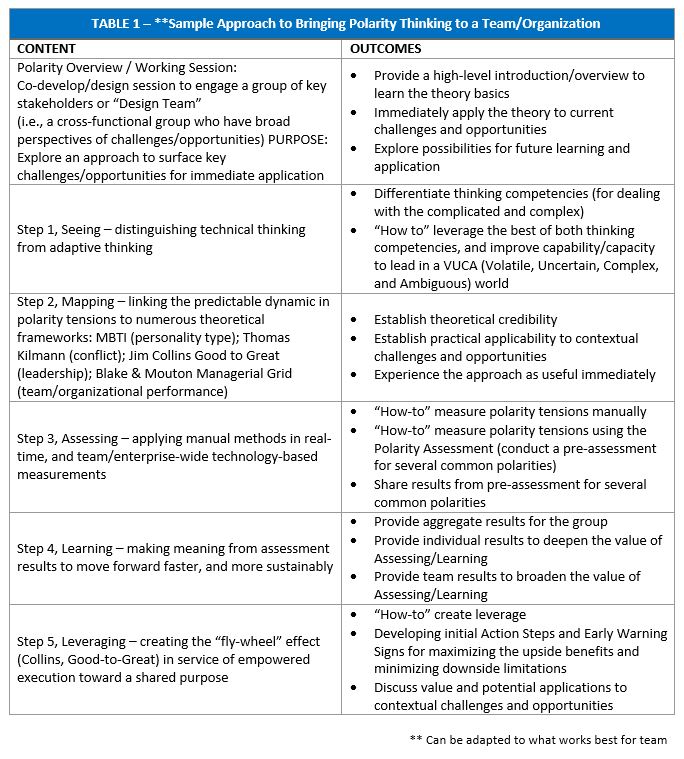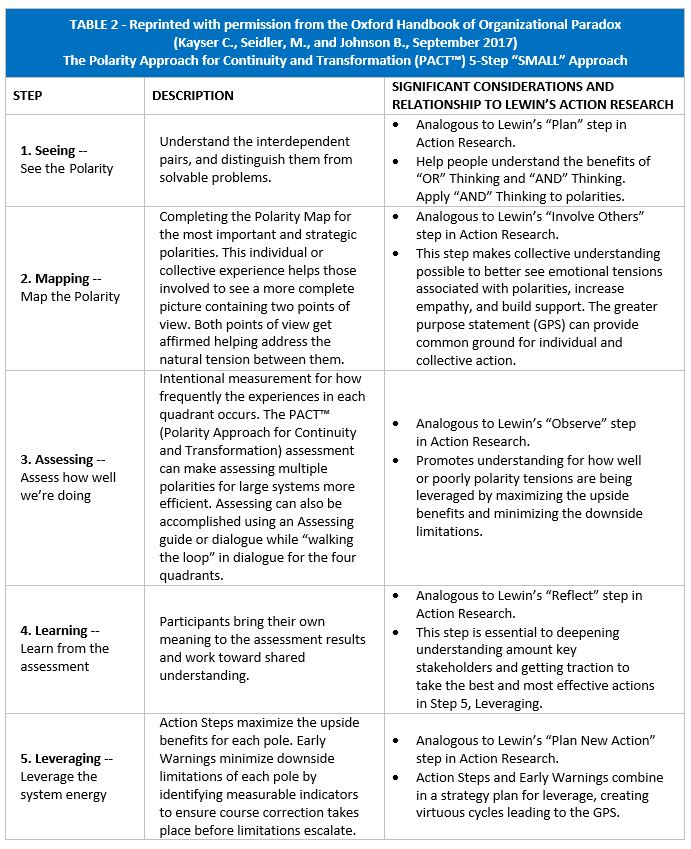Success today and in the future requires critical distinctions be made in the type of thinking that’s needed for challenges and opportunities. One type of thinking addresses complicated and solvable technical problems using “either/or.” Another type of thinking addresses complexity for technically unsolvable adaptive “polarity” challenges using “both/and.”
Polarities are interdependent pairs that all leaders, teams, and organizations are “in” – there’s no getting around them. As long as your organization is a viable entity, it will face polarities.
Those polarities are being leveraged more or less well now. And, they will be leveraged more or less well in the future.
A few examples of common polarities are:
Competence for Conflict Requires Leveraging Polarities Such as:
— Being Assertive AND Being Cooperative
— Being Confident AND Being Humble
Competence in Communication Requires Leveraging Polarities Such as:
— Being Candid AND Being Diplomatic
— Advocating AND Inquiring
Competence in Complexity Requires Leveraging Polarities Such as:
— Preserving Core Continuity AND Stimulating Change
— Focusing on the Margin AND Focusing on the Mission
— Internal Culture Focus AND External Environment Focus
Competence to Grow a Culture of Purpose and Trust Requires Leveraging Polarities Such as:
— The above competencies (Conflict, Communication, and Complexity)
— Focusing on Individual Performance AND Focusing on Team Performance
— Decentralizing AND Centralizing
— Giving Freedom AND Holding Responsible
The invitation into leadership often follows from problem-solving proficiency and it’s common for leaders to overuse “either/or” thinking as leaders, which creates polarization and unsustainable outcomes. In highly analytical environments such as healthcare, the tendency to overuse “either/or” technical problem-solving is higher. This, together with increasing change and complexity makes the imperative to develop “dual thinking” capacity and capability higher.
We support leaders to supplement and/or enhance “dual thinking” skills in real-time through coaching, team coaching, and reinforcing ties to organization strategy and culture development initiatives. We combine this with measuring performance for how well (or poorly) key polarities are being leveraged at the leader, team, and organizational levels. Advancements in measuring interdependencies is critical — what gets measured, gets done. And, the research is clear that leaders, teams, and organizations that leverage polarities outperform those that don’t.
Max DePree once said: “The first responsibility of a leader is to define reality.” Patrick Lencioni describes the most common realities in his book, “The Five Dysfunctions of a Team”:
- Absence of trust—unwillingness to be vulnerable within the group
- Fear of conflict—seeking artificial harmony over constructive passionate debate
- Lack of commitment—feigning buy-in for group decisions creates ambiguity throughout the organization
- Avoidance of accountability—ducking the responsibility to call peers on counterproductive behavior, which sets low standards
- Inattention to results—focusing on personal success, status and ego before team success
While acknowledging the realities of dysfunction may be therapeutic, Lencioni’s critics point to the need for identifying the root cause or causes of dysfunction, and this is the focus of retired Army General Stanley McChrystal’s 2015 book, “Team of Teams: New Rules of Engagement for A Complex World.” In 2004, when in command of the Joint Special Operations Task Force, McCrystal realized that conventional military tactics were failing as Al Qaeda’s decentralized network could move quickly, strike ruthlessly, then seemingly vanish into the local population. This was happening despite the fact that Allied forces had a huge advantage in numbers, equipment, and training. While not mentioning Lencioni, he touched upon every one of the five dysfunctions. McCrystal believed the root cause to be an absence of new “mental models” they learned in the trenches — literally and figuratively. Here’s a summary of a few, and it’s easy to see the polarities at play in each!:
Integrate Wisdom from Top-down and from the Bottom-up.
The new environment demands a new approach that continually taps into the best systemic thinking of the parts and whole to create increased trust and reinforce purpose. This approach imbues teams with an ability to solve problems that could never be foreseen by a single manager. Because of the required interdependence of the operating environment, members needed to understand the entire interconnected system, not just individual MECE boxes (mutually exclusive and collectively exhaustive), on the org chart. Teams that had traditionally resided in separate silos became fused to one another via trust and purpose. Bottom-up and top-down interactions were referred to as a “team of teams” where relationships resembled those between individuals on a single team.
Recognizing Technical Problem-solving Efficiency Isn’t Enough.
Most industries have subscribed to management doctrines informed by or similar to Frederick Taylor’s “Scientific Management,” a system that is excellent for achieving highly efficient execution of known, complicated, and repeatable processes. However, this system alone is insufficient to address the new generation of challenges. The world has become, in many ways, vastly less predictable and this unpredictability is fundamentally incompatible with reductionist managerial models based on planning and prediction.
Supplement Technical Competency with Complexity Competency.
The fast-pace of technological changes of recent decades has led to increasing awareness of interdependencies, creating a state of complexity different from what is complicated and solvable. Confronting today’s threats requires supplementing the complicated predictable with complexity competency. This provides resilience, continuous learning to reconfigure and confront the effective in responding to volatile, complex, ambiguous, and uncertain (VUCA) environments.
Disciplined Purpose and Trust to Create Shared Consciousness.
While systemic understanding was a valuable first step, trust was required to achieve the fluid, cross-force team-like cooperation needed. Embedding and liaison programs were used to create strong lateral ties between units, and with partner organizations. Systemic understanding mirrored the sense of “purpose” to bond small teams. This purpose mirrored the second ingredient: “trust.” Purpose and trust established shared consciousness, which was vital to success.
Discipline of Empowered Execution by Leaders.
Individuals and teams closest to the problem were given unprecedented levels of insights from across the network, which offered the best ability to make decisions and act decisively. The temptation to lead as chess master, controlling each move of the organization, had to give way to a gardener approach — directing through enabling execution. This was anything but passive as it required leaders to act with “Eyes-On, Hands-Off” to create and maintain an ecosystem. This yin-and-yang symmetry of shared consciousness is achieved through: strict centralized forums for communication; extreme transparency; empowered execution, and decentralization of managerial authority. (Author’s NOTE: SixSeed Partner, Larry McEvoy, MD describes this as an “epidemic of performance.”)
Beyond Dysfunction and Root Causes – “How to” Start Leveraging Polarities
Using a co-designed and developed experiential approach (See Tables 1 and 2) we engage in a partnership to co-design a working introduction to learn and apply a powerful 5-Step process.








